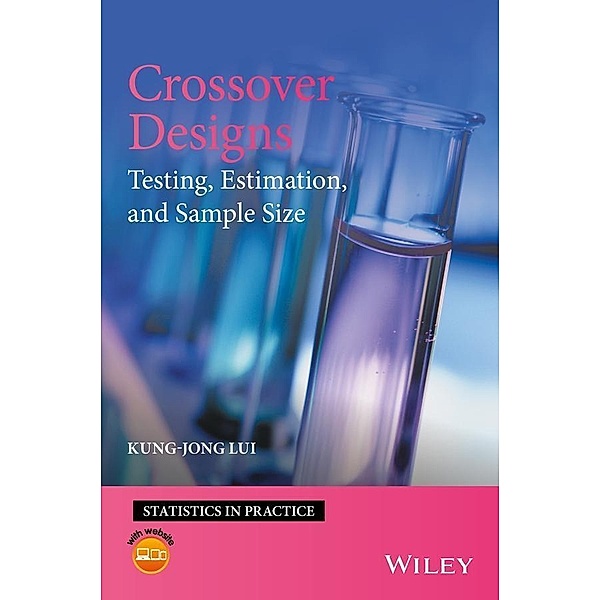Crossover Designs (PDF)
Testing, Estimation, and Sample Size
(Sprache: Englisch)
A comprehensive and practical resource for analyses of crossover designs
For ethical reasons, it is vital to keep the number of patients in a clinical trial as low as possible. As evidenced by extensive research publications, crossover design can be a...
For ethical reasons, it is vital to keep the number of patients in a clinical trial as low as possible. As evidenced by extensive research publications, crossover design can be a...
sofort als Download lieferbar
eBook (pdf)
75.99 €
- Lastschrift, Kreditkarte, Paypal, Rechnung
- Kostenloser tolino webreader
Produktdetails
Produktinformationen zu „Crossover Designs (PDF)“
A comprehensive and practical resource for analyses of crossover designs
For ethical reasons, it is vital to keep the number of patients in a clinical trial as low as possible. As evidenced by extensive research publications, crossover design can be a useful and powerful tool to reduce the number of patients needed for a parallel group design in studying treatments for non-curable chronic diseases.
This book introduces commonly-used and well-established statistical tests and estimators in epidemiology that can easily be applied to hypothesis testing and estimation of the relative treatment effect for various types of data scale in crossover designs. Models with distribution-free random effects are assumed and hence most approaches considered here are semi-parametric. The book provides clinicians and biostatisticians with the exact test procedures and exact interval estimators, which are applicable even when the number of patients in a crossover trial is small. Systematic discussion on sample size determination is also included, which will be a valuable resource for researchers involved in crossover trial design.
Key features:
* Provides exact test procedures and interval estimators, which are especially of use in small-sample cases.
* Presents most test procedures and interval estimators in closed-forms, enabling readers to calculate them by use of a pocket calculator or commonly-used statistical packages.
* Each chapter is self-contained, allowing the book to be used a reference resource.
* Uses real-life examples to illustrate the practical use of test procedures and estimators
* Provides extensive exercises to help readers appreciate the underlying theory, learn other relevant test procedures and understand how to calculate the required sample size.
Crossover Designs: Testing, Estimation and Sample Size will be a useful resource for researchers from biostatistics, as well as pharmaceutical and clinical sciences. It can also be used as a textbook or reference for graduate students studying clinical experiments.
For ethical reasons, it is vital to keep the number of patients in a clinical trial as low as possible. As evidenced by extensive research publications, crossover design can be a useful and powerful tool to reduce the number of patients needed for a parallel group design in studying treatments for non-curable chronic diseases.
This book introduces commonly-used and well-established statistical tests and estimators in epidemiology that can easily be applied to hypothesis testing and estimation of the relative treatment effect for various types of data scale in crossover designs. Models with distribution-free random effects are assumed and hence most approaches considered here are semi-parametric. The book provides clinicians and biostatisticians with the exact test procedures and exact interval estimators, which are applicable even when the number of patients in a crossover trial is small. Systematic discussion on sample size determination is also included, which will be a valuable resource for researchers involved in crossover trial design.
Key features:
* Provides exact test procedures and interval estimators, which are especially of use in small-sample cases.
* Presents most test procedures and interval estimators in closed-forms, enabling readers to calculate them by use of a pocket calculator or commonly-used statistical packages.
* Each chapter is self-contained, allowing the book to be used a reference resource.
* Uses real-life examples to illustrate the practical use of test procedures and estimators
* Provides extensive exercises to help readers appreciate the underlying theory, learn other relevant test procedures and understand how to calculate the required sample size.
Crossover Designs: Testing, Estimation and Sample Size will be a useful resource for researchers from biostatistics, as well as pharmaceutical and clinical sciences. It can also be used as a textbook or reference for graduate students studying clinical experiments.
Autoren-Porträt von Kung-Jong Lui
Kung-Jong Lui, Professor, Department of Mathematics and Statistics, San Diego State University, USA.
Bibliographische Angaben
- Autor: Kung-Jong Lui
- 2016, 1. Auflage, 248 Seiten, Englisch
- Verlag: John Wiley & Sons
- ISBN-10: 1119114691
- ISBN-13: 9781119114697
- Erscheinungsdatum: 08.08.2016
Abhängig von Bildschirmgröße und eingestellter Schriftgröße kann die Seitenzahl auf Ihrem Lesegerät variieren.
eBook Informationen
- Dateiformat: PDF
- Größe: 6.61 MB
- Mit Kopierschutz
Sprache:
Englisch
Kopierschutz
Dieses eBook können Sie uneingeschränkt auf allen Geräten der tolino Familie lesen. Zum Lesen auf sonstigen eReadern und am PC benötigen Sie eine Adobe ID.
Kommentar zu "Crossover Designs"
0 Gebrauchte Artikel zu „Crossover Designs“
| Zustand | Preis | Porto | Zahlung | Verkäufer | Rating |
|---|





Schreiben Sie einen Kommentar zu "Crossover Designs".
Kommentar verfassen